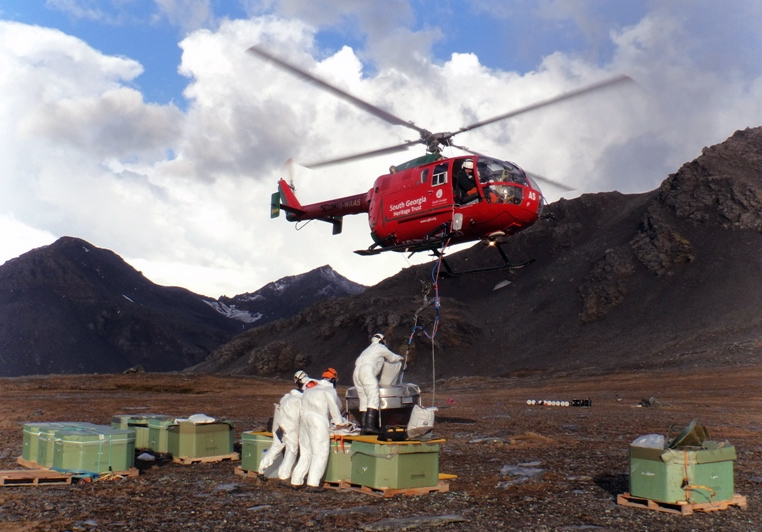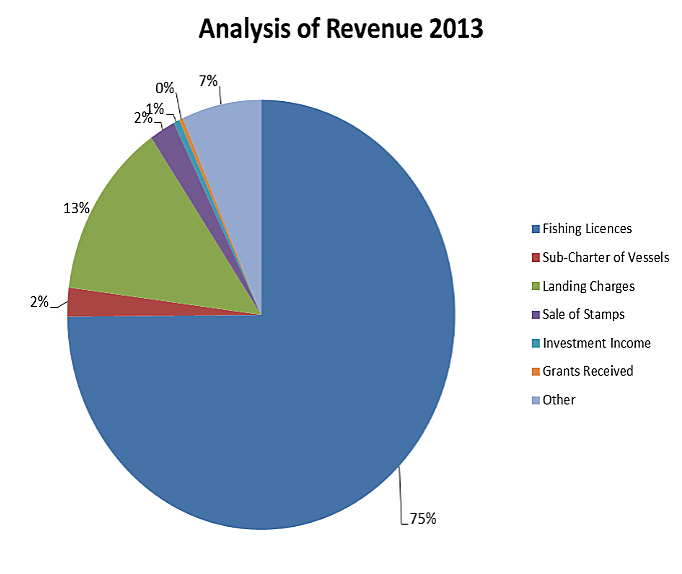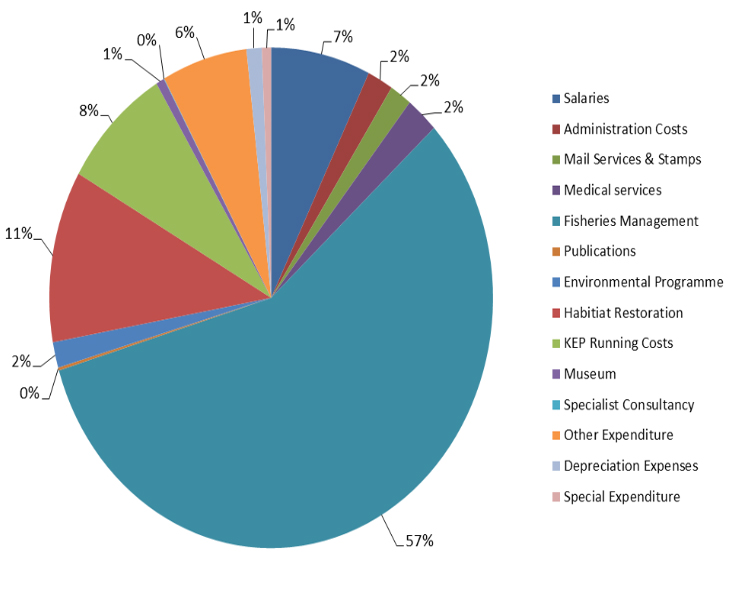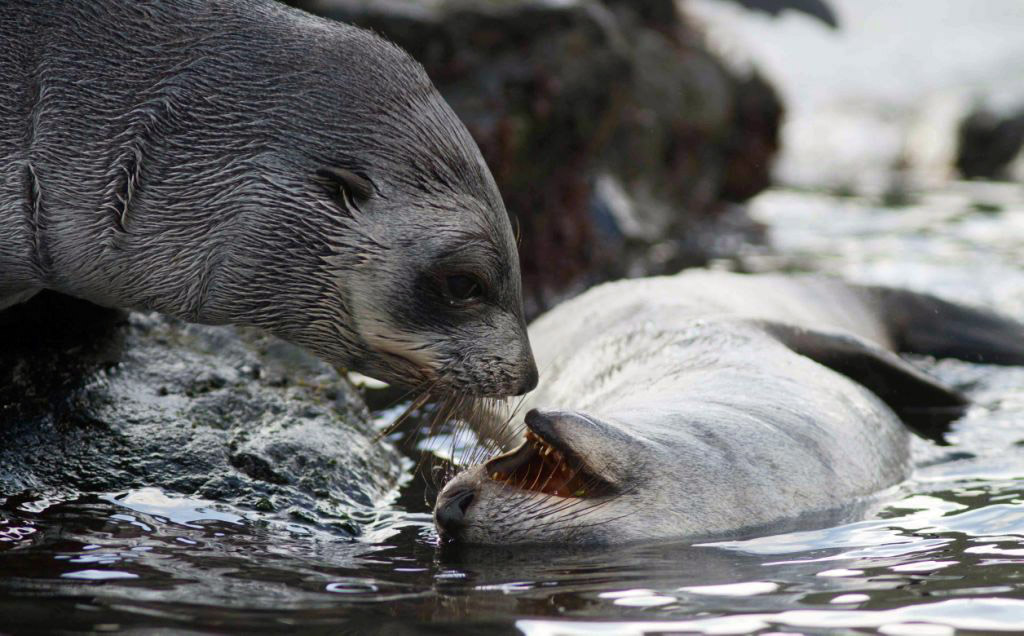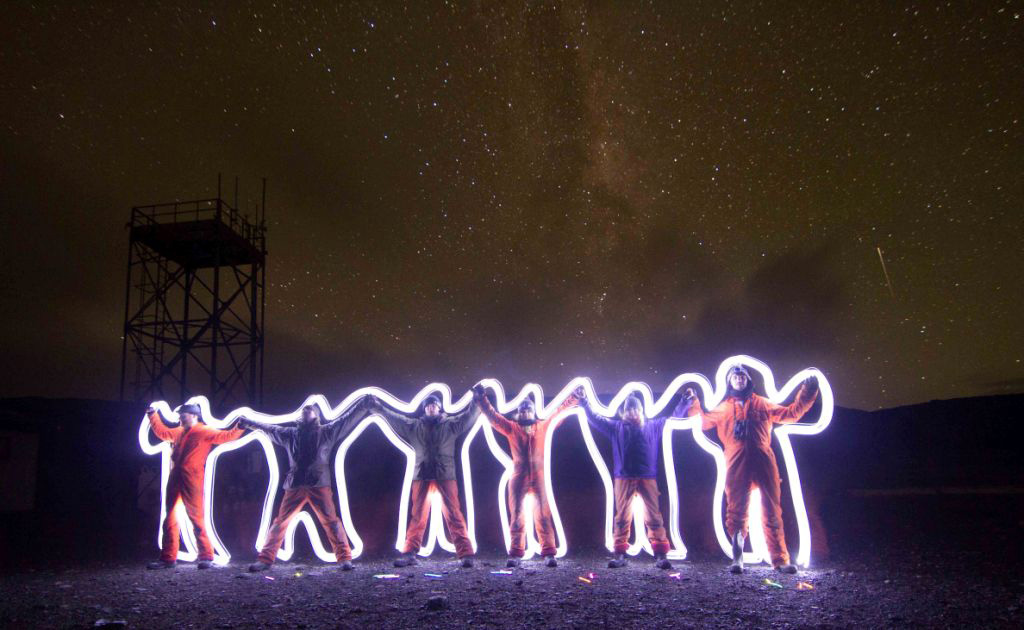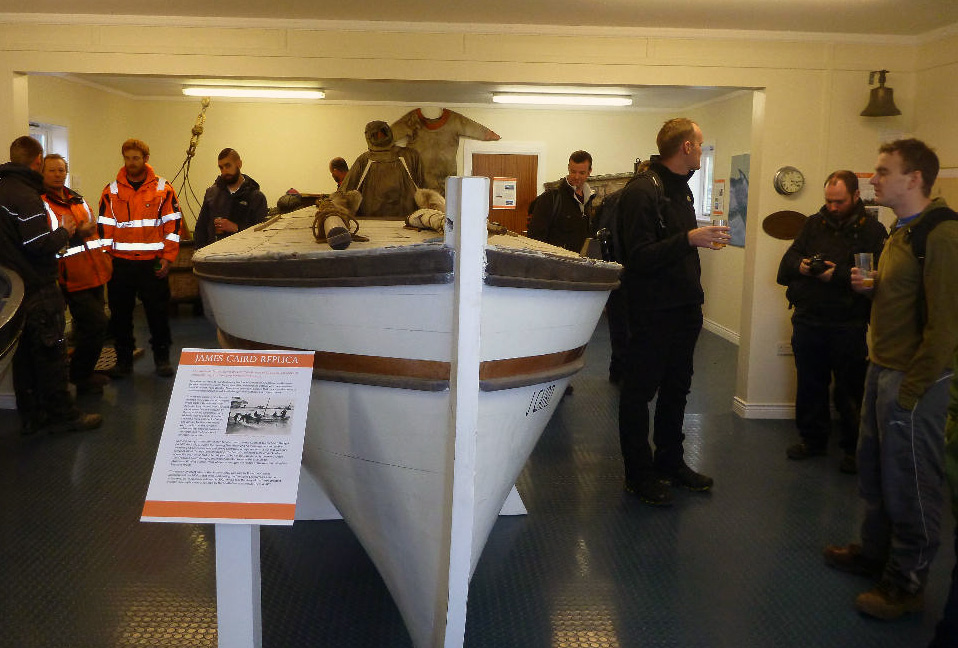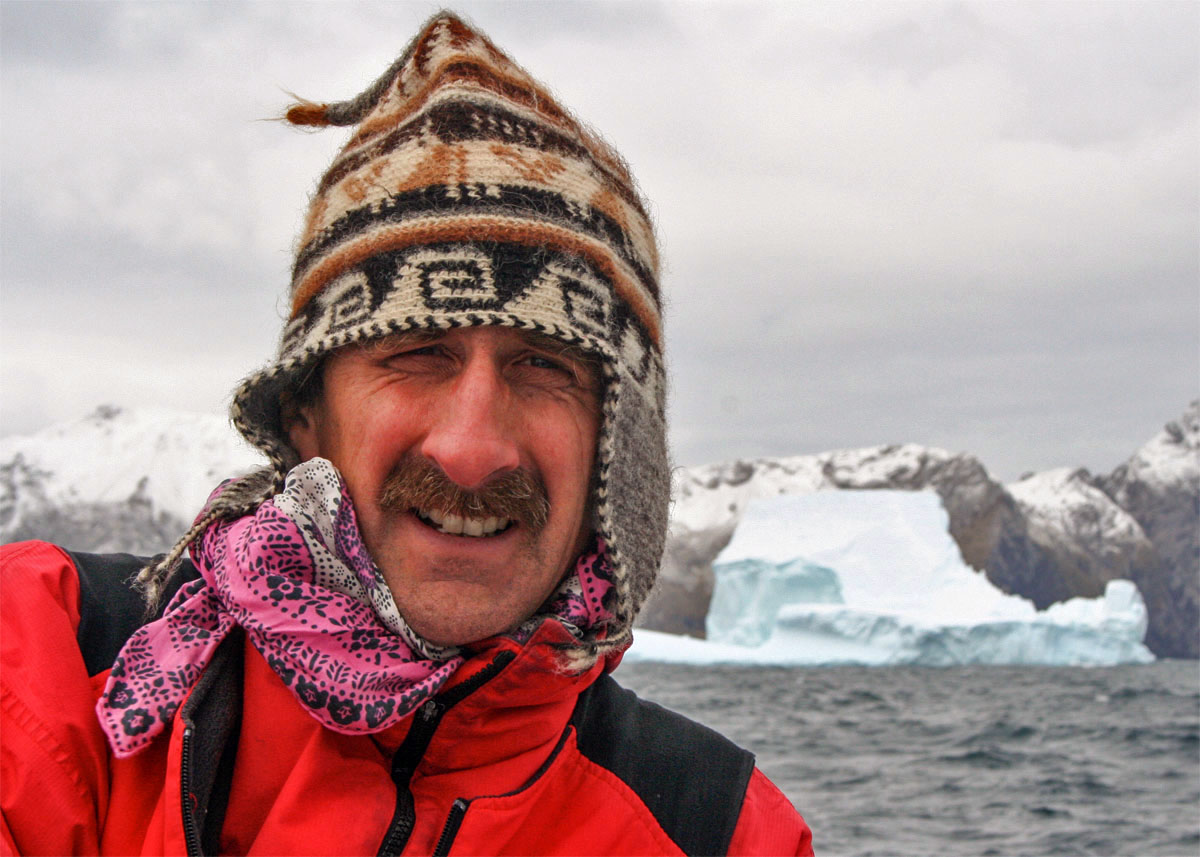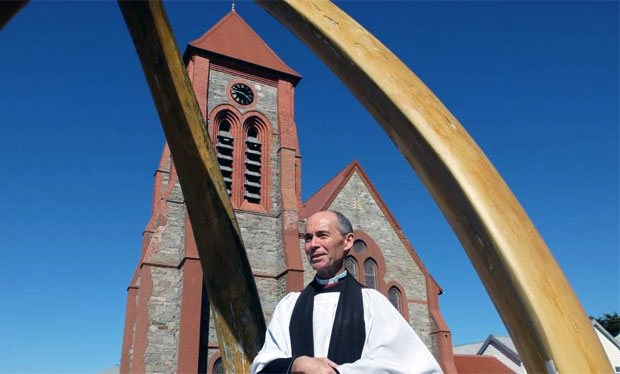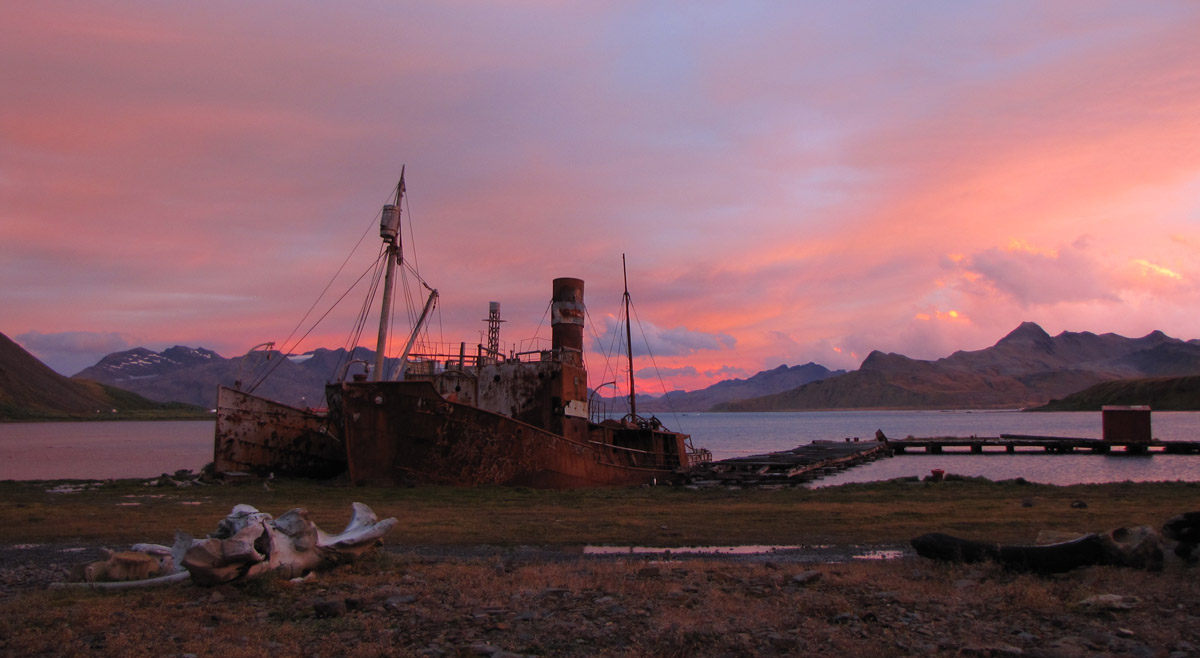This newsletter is not produced by GSGSSI; it does not necessarily reflect their views.
To subscribe to the SGIsland News Alerts list click here
Relief As Baiting Finished On World’s Largest Rodent Eradication
Baiting for the world’s largest attempted rodent eradication was completed on March 23rd. After several frustrating weeks, when one helicopter was put out of action after being damaged in a storm, and poor weather prevented the remaining two helicopters flying for weeks on end, the SGHT Habitat Restoration Project field team’s patience was rewarded. The job was completed by grabbing a few flyable hours here and there, when the wind was low enough and visibility good enough, to bait the tricky areas at the far south-eastern end of the island. One of the most difficult zones was the area around the field camp at Cape Charlotte, a very windy area which was the last area to be completed.
Baiting to remove the introduced rats that have had a devastating effect on the native populations of birds on South Georgia began four years ago. The trial area was in the centre of the island and, when that succeeded, the vast north-western section was then baited two years later. The work is not yet finished and, with the season drawing to a close, the team are busy installing and checking monitoring devices in the Phase Two area to see if any rats remain there, and they will be clearing up equipment before the team and all the kit and helicopters are picked up by ship in mid-April. The next step will be to monitor all the baited areas to see if the baiting has been successful in all areas of the island.
On completion of the Phase Three baiting, Project Leader Tony Martin wrote, “I have long thought about this moment. In many ways it has been the main aim of my professional life for the last five years, and at times seemed so far away, so I expected a sense of exultation when it finally arrived. Strangely, though, I watched that last load depart with mixed feelings. Overwhelmingly, I was relieved that this major goal has been achieved safely ……A third intense, exhilarating, frustrating, memorable field season is at an end!” Two editions of ‘Project News’, with all the news of the project progress, were published in March, one on March 8th, and a ‘Stop Press’ edition a fortnight later to mark the end of baiting.You can read both these editions
You can read both these editions here.
On the 27th March, GSGSSI announced that the Convention on Biological Diversity (CBD) would be extended to South Georgia and the South Sandwich Islands.
The Convention on Biological Diversity in an important multilateral environmental agreement that aims to conserve biological diversity, promote sustainable use of its components and ensure fair and equitable sharing of benefits arising from genetic resources. It was signed by the UK in 1992 and ratified in 1994, but that ratification did not include South Georgia and the South Sandwich Islands (SGSSI).
The extension of the CBD to SGSSI is a demonstration of the commitment of the GSGSSI and the UK Government to the conservation of the flora and fauna of South Georgia and the South Sandwich Islands and is, in part, a consequence of recent work to protect the biodiversity of the Territory. Achieving the extension of the CBD to SGSSI was been facilitated by close collaboration between GSGSSI, the Foreign and Commonwealth Office and the Department for Environment, Food and Rural Affairs (Defra).
As part of the ratification process GSGSSI had to demonstrate that there were sufficient laws and policies in place to enable the Territory to implement, and comply with its obligations under the CBD. A large body of evidence was collated in order to demonstrate this and show that biodiversity conservation is central to many of the strategy documents that set out the actions of GSGSSI.
Sustainable fisheries and protected areas are important focus points for the CBD bringing to the forefront the importance of the large (1.07 million km2) sustainable-use Marine Protected Area in the SGSSI 200 mile Maritime Zone. The sustainable management of the marine ecosystem is further evidenced by Marine Stewardship Council (MSC) certification of the fisheries operating within the Maritime Zone.
Another priority area for the CBD is in the protection of the terrestrial biodiversity. Great progress has been made within SGSSI in this area though world-leading programmes to eradicate introduced reindeer and rodents and to control non-native plants.
With the CBD ratified on SGSSI, the Territory will contribute to UK reports to the Convention. This is an important opportunity both to showcase the cutting edge conservation work that is on going in the Territory on a global stage and to learn from and forge links with other nations who are committed to protecting their biodiversity.
The residents of South Georgia joined in a global event, ‘Fly a Flag for the Commonwealth’, to celebrate Commonwealth Day on March 9th. The Commonwealth flag was raised in 730 locations around the world including King Edward Point (KEP) and Bird Island. Photographs of the flag raisings were sent to London and a selection were going to be presented to Her Majesty the Queen.
The Queen wrote the following to those participating, “I am pleased to learn that so many people throughout the Commonwealth will be taking part in the ‘Fly a Flag for the Commonwealth’ initiative on Commonwealth Day this year, which I understand will see the raising of a record number of Commonwealth flags. I send my good wishes to all who are taking part. ELIZABETH R.”
The Commonwealth of Nations, commonly known as the Commonwealth is an intergovernmental organisation of 53 member states that were mostly territories of the former British Empire. The Commonwealth dates back to the mid-20th century with the decolonisation of the British Empire through increased self-governance of its territories. Queen Elizabeth II is the Head of the Commonwealth. Member states are united by language, history, culture, and their shared values of democracy, human rights, and the rule of law. The Commonwealth covers nearly 30 million km2, almost a quarter of the world land area, and spans all the continents. With an estimated population of 2.328 billion, near a third of the world population.
The Commonwealth of Nations, commonly known as the Commonwealth is an intergovernmental organisation of 53 member states that were mostly territories of the former British Empire. The Commonwealth dates back to the mid-20th century with the decolonisation of the British Empire through increased self-governance of its territories. Queen Elizabeth II is the Head of the Commonwealth. Member states are united by language, history, culture, and their shared values of democracy, human rights, and the rule of law. The Commonwealth covers nearly 30 million km2, almost a quarter of the world land area, and spans all the continents. With an estimated population of 2.328 billion, near a third of the world population.
The Commonwealth flags were raised at 10am local time at all locations, making the event one that would span a whole day. At KEP all the locals gathered under the flag pole which is just behind the beach in front of the science base. At 10am the Commonwealth Flag, a blue flag with the Commonwealth symbol, a ‘C’ of golden blazes surrounding a globe, was raised. As the stiff breeze fanned the flag against a blue sky, Government Officer Simon Browning read a description celebrating the Commonwealth, finishing with the words “Joining together as members of one worldwide Commonwealth community, and valuing the personal dignity and worth of every citizen, we raise this flag as a symbol of the ties of kinship and affinity that we cherish. We draw inspiration from our diversity, and the opportunities for working together, as a rich source of wisdom and a powerful influence for good in the world. We affirm our commitment to upholding the values set out in the Commonwealth Charter, to serve one another in a spirit of respect and understanding, and to advancing development, democracy and cooperation locally, nationally and internationally.” After the flag raising, port was served on the veranda and a toast was raised to the Commonwealth and to South Georgia.
This was only the second ever ’Fly Flag for the Commonwealth’ event, which started last year, and Bruno Peek LVO OBE OPR – Pageant-master of the event, said, “I am amazed how quickly this event has caught the public imagination in so many Commonwealth countries. We are only in our second year, and the involvement of so many people of all ages and from all walks of life shows the enormous potential of this project and of the Commonwealth. It is a positive and uplifting way for people to link with fellow citizens of the Commonwealth in a family that spans across oceans and continents. There is a real sense of promise, and hope for the future.”
The SGSSI Financial Statements for the year ending 31st December 2013 have just been published on this website and area available to download here. The statements shows a surplus of £130,000 for the year. The revenue for 2013, of £6,335,000, was the highest ever recorded, whilst the total expenditure, of £6,205,000 was the second highest (expenditure in 2003 was £244,000 more).
As usual, the primary source of revenue was the sale of fishing licences for the toothfish, icefish and krill fisheries, bringing in £4,742,000. The second highest earner was (tourist) landing charges which raised £847,000.
Fisheries Patrol costs (£3,040,000) accounted for the greatest portion of expenditure. The second highest expenditure was for the reindeer eradication project (£688,000).
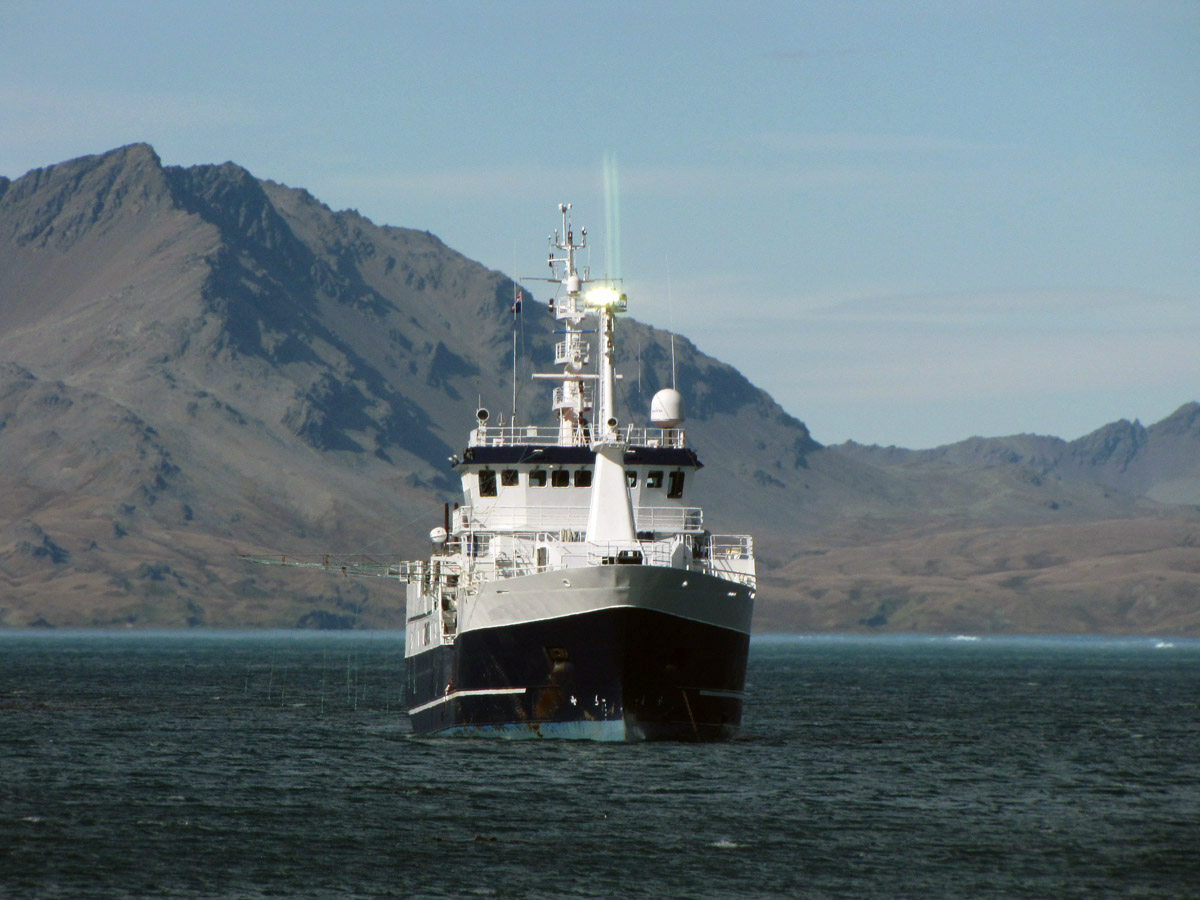
First longliner of the toothfish fishing season in for inspection and licensing before heading for the South Sandwich Islands to fish.
As the tourist season comes to an end, nine cruise ships visited South Georgia in March. There was a tenth vessel that visited the Territory, but it did not come to South Georgia, it only visited the South Sandwich Islands. There is just one more cruise ship left to visit this season, due on April 2nd.
Three of the March ships had their landings at Grytviken delayed by high winds. In all three cases, when the ships first arrived in the early afternoon the winds were too high to safely launch the Zodiacs to land the passengers, but in all cases the wind dropped sufficiently by later afternoon to allow a landing. One of the visiting vessels was an entire Chinese charter, bringing 200 Chinese speakers. Chinese parties regularly make up a large group on board other tourist vessels, but entire Chinese charters are also becoming more common.Two yachts also called in to Grytviken. One had damage to its mast rigging and repairs were made whilst it was alongside the jetty at Grytviken. The vessel sailed but returned within 24hrs as the rigging had failed again and needed more work before the yacht could sail away from the island.
Two yachts also called in to Grytviken. One had damage to its mast rigging and repairs were made whilst it was alongside the jetty at Grytviken. The vessel sailed but returned within 24hrs as the rigging had failed again and needed more work before the yacht could sail away from the island.The toothfish fishing season started in late March. On March 25th a longliner was inspected and licenced to fish in the South Sandwich Islands Fishing Zone.
The toothfish fishing season started in late March. On March 25th a longliner was inspected and licenced to fish in the South Sandwich Islands Fishing Zone.
By Gandhi Suppiah, CEng, MICE
I am a civil engineer and was commissioned by GSGSSI to carry out structural inspection and general assessment of the abandoned whaling station of Grytviken. I had the privilege of sailing in March to visit one of the distant corners of the world, South Georgia.
Amongst the structures I was asked to assess were the Tijuca Jetty, KEP Jetty and the two dams (hydro and potable water). My visit was cut to just two days, so it was a very busy time.
Spectacular and amazing are some of the words that came to my mind when GSGSSI Building Supervisor Dave Peck gave me the grand tour of Grytviken. I was amazed by the scale of the station and marvelled at the engineering ingenuity of Carl Anton Larsen in developing the station. The attention to detail and creativeness to construct the station at the bottom of the world in such remote location is astounding.
In the last 20 years I have travelled to many countries with work and marvelled at the engineering ingenuity using metal in the mid to late 1800’s and early 1900’s, such as the steel bridges and structures in Myanmar, in particular the Goteik viaduct, the San Sebastian Steel Church in the Philippines and Isambard Kingdom Brunel’s steel structures in the UK. Some of Grytviken whaling station’s steel structures are in the similar scale of complexity, ingenuity and quality. However I suspect due to the station being located at the bottom of the world, the creativity of Grytviken has not received the accolade it should. One of my main tasks was to carry out structural inspection of the main structures in the whaling station and propose potential solutions that will help preserve and maintain the aesthetics of these structures. However, and more importantly, to assess the stability of some of the structures in relation to safety of visitors and personnel working around the station.
Maintenance of some, if not all, the main steel structures will be required in the coming years to preserve the safety and attractiveness of Grytviken, however this will require substantial investment. From an engineer’s point of view it will be a shame to see the ingenuity of Grytviken whaling structures deteriorate further.
Studies of killer whales (Orca) in South Georgia waters may help fishermen avoid the whales stealing the fish off the fishing longlines (termed depredation). Researchers from CEFAS, BAS and GSGSSI set out to gain an understanding of where, when, and how much depredation occurs in the toothfish fishery around South Georgia by examining catch rates, mammal abundance, movement, and mammal-vessel interactions. Their studies led to new insights into mammal depredation behaviour around the island, enabling them to suggest new ways to reduce depredation. The resulting paper was published by PLOS ONE on March 4th.
The effect of whales eating fish off longlines reduces the valuable catch of toothfish and other fish species and can result in considerable financial loss to fishermen. The unrecorded loss of fish can also make stock assessment, and so long-term management of fisheries, more difficult.
Killer whales are not the only animals to take fish off the fishermen’s longlines in the South Georgia area however. Other animals that will take fish include fur seals and sperm whales, and a third of longlines set in the region are affected by predation by these animals. Killer whales however are by far the biggest offenders. They actually interact with less longlines, but when they find a line they can take more than half of the catch.
The researchers found that killer whales mainly work in smaller areas of the South Georgia fishery, and these areas possibly coincide with the migration routes of the whales. Off South Georgia, killer whales are mainly encountered north of Cumberland Bay and around Shag Rocks. Unfortunately these areas are also popular with the fishermen at the same time that the whales are moving through.
Over the years several measures have been tested to try to reduce depredation by killer and sperm whales. These include acoustic harassment devices and physical protection of the catch by nets, hooks or wires. Changes in fishing practice have also been tried, such as moving to a different area when killer whales are present, changing offal dumping practises or using lines of different length, but these measures have only had limited success. The most effective method so far has been to leave the line and for the fishing vessel to move a substantial distance away when killer whales arrive, returning to collect the line later.
The paper suggests that understanding the seasonal behaviour of the whales, and analysing where most depredation happens, could be used to reduce the effect they have on the fishery. The fishermen could avoid some whale predation by not setting lines in the areas when the whales are likely to be migrating through. Indeed, the scientists suggest that fishing in less profitable but killer whale-free areas could be a trade-off worth considering for the fishermen.
You can see the paper on the PLOS ONE website here.
By Jerry Gillham, Zoological Field Assistant for the penguins and petrels at the BAS Research Station at Bird Island.

Ready-to-fledge northern giant petrel chick. Despite a 2m wingspan this one looked alarmingly small standing amongst displaying wandering albatrosses. Photo Jerry Gillham.
March on Bird Island feels very like autumn; the days are getting noticeably shorter, more mornings are greeting us with ice and snow, and the summer residents are preparing to leave. The first chicks of the northern giant petrels have begun to depart. With their almost completely black plumage they look extremely smart, even when stumbling across the beach or inexpertly jumping up, desperately flapping their wings when attempting their first flights. Prior to their departure we went around the study area recording weights and bill lengths of all the chicks. Each one got a unique ring number so it can be identified when it hopefully returns to breed in five to eight years’ time. Where it will go in the intervening time is still largely unknown but they will certainly get to see a lot of the south polar sea as they circumnavigate the Antarctic.
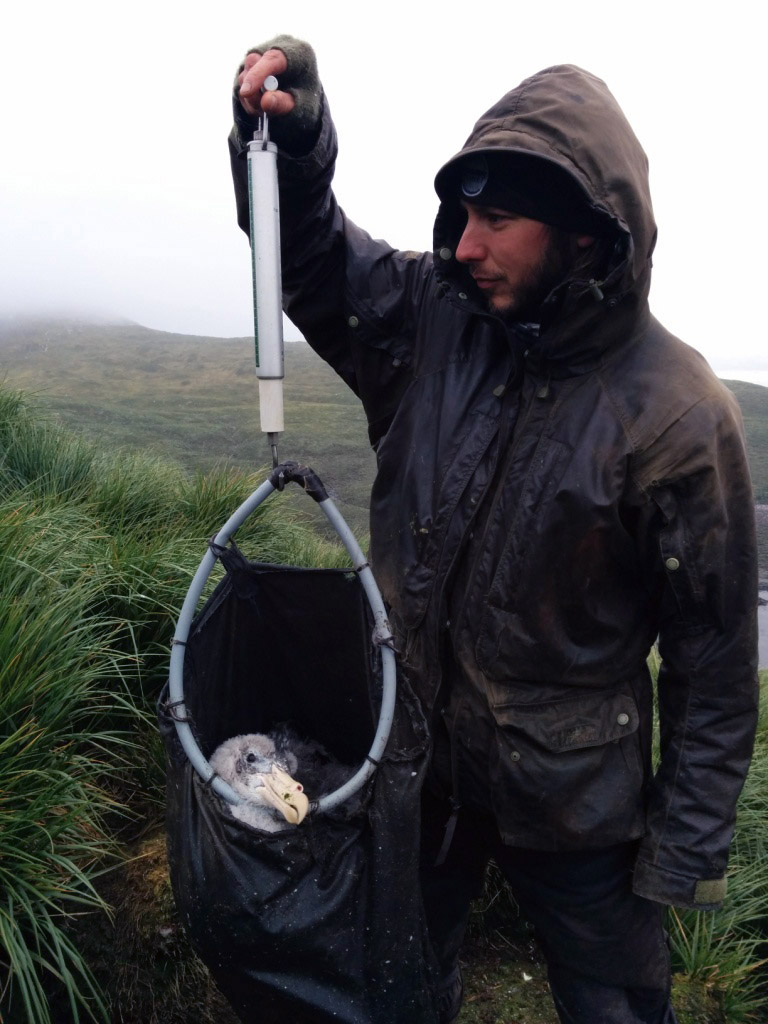
Weighing a giant petrel chick. Comparing chick weights at the same stage each year tells us how healthy they are, how abundant food has been that year and will potentially allow us to predict their survival chances. Photo Alastair Wilson.
The penguin chicks have all departed, heading off for their new life at sea, while their parents will follow them once they have moulted. It was strange seeing the macaroni colonies empty completely for a few weeks and then fill up again with fat adults, standing around shedding worn old feathers as fresh new ones grow through. The whole colony looks like an old feather duvet has exploded, it’s impossible to do any work there without finding moulted feathers in your pockets, bag and mouth.
By the end of February we’d started hearing the first peeping noises emanating from beneath the wandering albatrosses on their nests as the chicks started poking their heads through tiny holes in the eggs, hatching over the next day or two. Those first chicks have grown rapidly and it’s amazing to think that such a young bird is now the size of a large duck. Daily rounds of the wandering albatross study area to record hatching dates tells us that the vast majority are now sitting on chicks. By attaching tiny GPS loggers to the adult birds we are finding out exactly where they go to feed in this vital period. Through understanding their key foraging and feeding areas and environments we can hopefully preserve them, reduce fishing impacts and ensure the long term success of this iconic, vulnerable species.
It’s currently a joy to see the fur seal pups embarking on their first adventures in the water; play-fighting, washing, breaching. You frequently see them chasing giant petrels or pintail ducks that are sitting on the surface, or grabbing a bit of kelp between their teeth and thrashing it from side to side. We’ve had the first light dustings of snow and ice on the beach and they seem to lose their minds with excitement, rolling over on their backs in it, scratching and sliding.
Low tides have found us shifting rocks and digging up mud this month in an attempt to clean up the old stone jetty. This was put in when the base was rebuilt ten years ago, created on a foundation of stone-filled industrial sacks. Over the years the earth that covered these has been washed away and the plastic edges of the bags have started to fray. Before they become an environmental problem we’ve decided to remove them. This means digging out, by hand, a tonne of stones, gravel and silt from each one, usually battling against the stream and the incoming tide. Seeing a group of us out there in our orange boiler suits, breaking rocks and shovelling dirt, you’d think we were manacled together, yet there is a great satisfaction when a bag is ripped free of the earth and we know we’re leaving the island a better place.
On one of our rare clear nights we headed out to observe the universe and take some photos of the stars. As the clouds encroached we thought our time was done until the appearance of a number of torches and glowsticks with which we were able to create our own artworks.
The preparations are well underway for the winter season. With the exception of one short holiday and one long trip to the dentist I have been on Bird Island since November 2012. With less than a month to go before my departure I find myself going through a mix of emotions. Things I’m looking forward to: spending time with friends and family; watching live music and sport; forest walks and swimming. There’s also sadness and melancholy, like at the end of the most amazing holiday you’ve ever experienced – you always knew it couldn’t last forever and are so grateful you’ve experienced it, but it doesn’t make the end any easier. And how am I going to be able to cope with the crowds of people, shops and traffic? BI has been the most amazing place to live and work.
Redisplay of the Carr Maritime Gallery: The South Georgia Museum held an event on March 13th to mark the reopening of the Carr Maritime Gallery following a major redisplay. The redisplay was the major exhibition project of the season for Curator Deirdre Mitchell. She altered the layout of the gallery to highlight the local historic vessels Dias, Albatros, Louise and Petrel and to have sections on nautical themes such as navigation and safety at sea. The redisplay allowed for several recently arrived artefacts to go on display including the bell of the Albatros and a water colour painting of the Dias and Albatros by well know Antarctic painter David Smith.
A Mist of Whale Breath: To cap off an exceptional season for whale sightings around the island, one of the late-season tourist vessels, Silver Explorer, encountered a pod of around 500 fin whales on March 13th. One of the people on board described how the ship found itself in the centre of a vast pod of whales and how there was, “…a mist of whale breath on both sides of the vessel.” The vast aggregation of whales was to the north west of the island in the vicinity of Shag Rocks.
Blue Water Medal for Yachtsman Skip Novak: Skip Novak, a regular visitor to South Georgia as both yachtsman and climber, has been awarded the Cruising Club of America’s accolade for sailors, the Blue Water Medal. The Blue Water Medal was awarded to Skip in recognition of his many years of cruising and exploring the Antarctic. The award was presented in a ceremony on March 6th. Skip, who has sailed since he was young, has raced in four ‘Whitbread around the World’ races and in 2001 co-skippered the 33-meter catamaranInnovation in ‘The Race Around The World In 65 Days’. In 1987 he designed the first of his two yachts,Pelagic, for exploring the southern high latitudes and to allow him to pursue his passion for mountaineering. The larger Pelagic Australis followed, and both yachts are now available for charter in the southern region, and are often used to support mountaineering expeditions.
New Hut at Coral Bay: A hut that was built for the reindeer eradication project and placed on Tonsberg Peninsula, Stromness Bay, to house the herding team has been moved to a new location. Two large huts were erected for the project. The first was moved to Hound Bay earlier this summer, now the second one has been erected to replace the old hut at Corral Bay, which is directly across Cumberland Bay from KEP. The bay is a good place to land from small boats as there is a small protected cove in front of it. From Corral it is an easy to walk to Rookery Bay and Godthul, and it gives access to the north-eastern end of the Barff Peninsula. The huts are used both for field workers and for locals from KEP taking short breaks.
Weird Penguin: This weird looking, mainly white, penguin was photographed recently at Gold Harbour. Jerome Viard, one of the chefs at the nearby SGHT field camp at Cape Charlotte, walked to the nearby penguin colony and said this misfit was easy to spot amongst the myriad of normal looking king penguins. The bird is missing the dark grey mantle king penguins usually have covering their back and flippers, and its freaky spotted white feet make it look especially odd. Jerome said it was also much bigger than the other penguins around it!
An Island Parish: Series nine of the popular BBC2 series ‘An Island Parish’ is following the working life of Reverend Richard Hines in the Falkland Islands. Reverend Hines was minister to the largest Anglican parish in the southern hemisphere. He is shown flying in small planes from one Falkland island to the other – even travelling as far as South Georgia, a far flung corner of his parish. The six part series is currently being shown on BBC2. Each episode is half an hour, and those already broadcast can be watched on line. South Georgia features in the episode covering Christmas when the Rev Richard and his wife Jen celebrated Christmas on South Georgia. This episode will be repeated on BBC2 on April 22nd at 08.15am.
You can catch all the episodes broadcast so far here.

